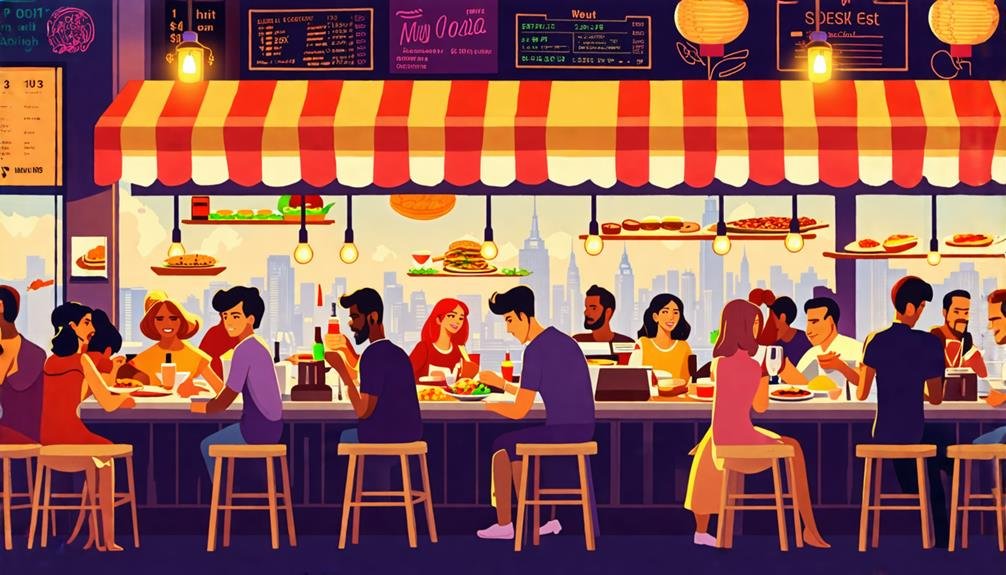In New York City, dining out includes a total sales tax of 8.875%. This tax is comprised of a 4% state tax, a 4.5% city tax, and a 0.375% charge that supports the Metropolitan Commuter Transportation District.
Consequently, a $20 meal incurs about $21.78 in total costs, reflecting these taxes. It's essential to consider this when planning your expenses for dining in the city.
Be aware that additional charges such as tourism and health levies may also apply, impacting the overall cost of your meal.
This insight into the tax structure not only helps in budgeting but also enriches your understanding of the economic framework of NYC's culinary scene.
Key Takeaways
- In New York City, the cumulative sales tax rate applied to restaurant bills totals 8.875%.
- This composite rate encompasses a 4% New York State tax, a 4.5% New York City tax, and an additional 0.375% for the Metropolitan Commuter Transportation District (MCTD).
- The sales tax is levied on the entire amount of the bill, including both food and service charges.
Understanding NYC Sales Tax
When dining out in New York City, it's essential to account for the combined sales tax rate of 8.875% applied to your meal. This rate includes New York State's 4% tax, an additional 4.5% for the city, and a 0.375% contribution to the Metropolitan Commuter Transportation District (MCTD).
This comprehensive tax affects the total cost of both your food and any separately stated service charges. For instance, a menu item listed at $20 will actually cost approximately $21.78 after the inclusion of sales tax.
Being aware of this added expense can help you manage your dining budget more effectively and avoid any surprises when the bill arrives. Remember, the enjoyment of your meal comes with a financial responsibility that reflects both state and city funding needs, contributing to the broader community and transit services.
Additional City-Specific Levies
In New York City, beyond the standard sales tax, diners may encounter additional city-specific levies at restaurants that contribute to various local services and initiatives.
A notable levy is the Tourism Improvement District (TID) fee, which is selectively applied to support city tourism through marketing and promotional efforts. Although not universally imposed, this fee can slightly increase your dining expenses where applicable.
Another indirect cost comes from the Health and Sanitation inspection fee. While this fee isn't itemized on your bill, it influences the overall pricing of menu items. Restaurants incur costs to meet health standards and the financial burden of regular inspections often translates into slightly higher menu prices.
Furthermore, certain neighborhoods, particularly those experiencing development or revitalization, might implement localized levies to fund projects aimed at enhancing community infrastructure and, by extension, the dining experience. These levies, while contributing to a higher dining cost, support enhancements that benefit the aesthetic and functional quality of the neighborhood, enriching the overall ambiance and safety of dining areas.
These additional levies reflect a commitment to maintaining high standards of public health, safety, and enjoyment, while also fostering local economic growth and community well-being.
As a diner, understanding these charges can enhance appreciation of the efforts made to sustain the vibrant dining culture and infrastructure of New York City.
Impact of Taxes on Menu Prices
When dining out in New York City, it's important to understand that the prices listed on the menu aren't solely reflective of food and service costs. Instead, these prices are significantly shaped by local and state taxes. New York City restaurants must incorporate these taxes into their pricing structures to meet their fiscal obligations, resulting in higher menu prices compared to other regions.
The elevated menu costs in New York City stem not only from the expensive operational environment but also from the cumulative impact of sales taxes, use taxes, and specific city levies. These financial obligations are seamlessly integrated into the menu prices you encounter, ensuring that what you pay covers both the culinary experience and the necessary contributions to public coffers.
This integration of taxes into menu pricing is emblematic of the broader economic realities of New York City, reflecting the interconnectedness of business operations and municipal financing. It underscores the city's reliance on such revenues for maintaining and enhancing public services, thereby linking your dining experience to the fiscal health of the community.
As a diner, this adds a layer of civic participation to your meal, making you a partner in supporting the urban infrastructure and services, beyond just enjoying a meal. The awareness of this dynamic can enrich your dining experience, adding a sense of community contribution and financial awareness.
Tax Exemptions for Restaurants
Certain tax exemptions tailored for restaurants can significantly ease financial strains, particularly in high-cost areas like NYC. These exemptions cater directly to critical operational needs, making them vital for cost management.
Here's an overview of key tax exemptions that could be transformative for your restaurant:
- Sales Tax Exemption on Raw Food Items: Essential ingredients such as vegetables, meats, and grains, intended for meal preparation, aren't subject to sales tax. This exemption supports keeping food costs manageable.
- Utility Tax Exemption: This allows restaurants to exclude costs related to utilities like gas and electricity, which are directly used in food production, from their taxable expenses. It's a relief that directly affects the bottom line by reducing utility bills.
- Commercial Rent Tax (CRT) Relief: In specific parts of Manhattan, reduced CRT rates or full exemptions are available, which can substantially decrease leasing expenses. This is particularly beneficial in an area where rent can be a major overhead.
Leveraging these tax exemptions can significantly reduce operating costs and improve profit margins. They reflect a deeper understanding of the challenges faced by the culinary industry, offering practical solutions to enhance financial health and sustainability.
Navigating Tax Compliance
Navigating tax compliance effectively ensures that your restaurant remains operational, adheres to legal standards, and maintains a good standing in the community. It is essential to stay informed about the latest tax laws and regulations.
Here's a concise guide to key compliance deadlines:
| Requirement | Deadline | Consequence of Non-Compliance |
|---|---|---|
| Sales Tax Filing | Quarterly | Penalties, accrued interest |
| Payroll Tax | Bi-weekly/Monthly | Fines, potential criminal charges |
| Health Inspection | Annually | Possible closure, fines |
| Liquor License Renewal | Every 2 years | License suspension |
Meeting these deadlines is crucial. Delays or oversights not only lead to financial burdens but can also tarnish your restaurant's reputation. Regular meetings with a tax advisor who specializes in the restaurant industry are advisable. They can provide guidance through the complexities of tax compliance, ensuring you leverage all possible tax benefits and stay proactive in managing your restaurant's fiscal responsibilities.
This strategic approach not only helps in maintaining compliance but also in fostering trust and confidence among your patrons, reinforcing your establishment's reputation as a reliable and conscientious community member.
Frequently Asked Questions
Are Tips Subject to Sales Tax in NYC Restaurants?
In New York City, tips left for restaurant staff are exempt from sales tax if they're voluntary and itemized separately on the bill. This ensures that gratuities go directly to the service employees, unburdened by additional taxes.
However, mandatory service charges imposed by the restaurant may be subject to tax as they're considered part of the billable service.
This distinction underscores the city's respect for the hardworking service industry, ensuring that voluntary expressions of appreciation remain intact and meaningful, directly benefiting those who enhance your dining experience.
How Does Outdoor Seating Affect Tax Rates for Restaurants?
Outdoor seating doesn't influence the tax rates for restaurants.
Regardless of whether diners choose to eat indoors or outdoors, the applicable sales tax rate is determined by the restaurant's physical location.
Therefore, the ambiance of dining under the stars in New York City doesn't alter the standard tax rates enforced by the city.
This ensures that the tax consistency provides a dependable financial environment, both for diners understanding their bill and for restaurant owners in managing their taxation obligations.
Can Restaurants in NYC Benefit From Tax Holidays?
Surprisingly, tax holidays in NYC, designed to reduce costs on items like clothing and school supplies, don't include restaurants.
Nevertheless, these holidays might indirectly benefit dining establishments as consumers, feeling financially lighter, may choose to eat out more.
It's always beneficial to stay informed about local tax regulations to capitalize on any unforeseen advantages.
This reflection of community support through indirect spending highlights the interconnectedness of local economies and the ripple effects of financial incentives.
Are Delivery and Takeout Orders Taxed Differently Than Dine-In?
In New York City, the taxation of delivery, takeout, and dine-in orders is uniform, ensuring a seamless and equitable financial experience whether you dine at a restaurant or enjoy your meal at home.
This consistent sales tax policy simplifies budgeting for meals, regardless of the dining format you choose, reflecting the city's commitment to straightforward and fair tax regulations for all residents and visitors.
Does Tax Rate Vary for Restaurants Serving Alcohol?
In New York City, the tax structure for restaurants that serve alcohol is more complex than for those that do not.
While the base sales tax rate applies universally, establishments holding a liquor license incur additional fees and must adhere to specific regulations, which can increase the overall cost of dining there.
Consequently, when enjoying alcoholic beverages at a restaurant, expect the total expense to be marginally higher.
Plan accordingly for a more enjoyable and budget-friendly evening.
Conclusion
Navigating NYC's tax framework may initially seem daunting, yet mastering the essentials can actually enhance your restaurant's operation.
The city levies an 8.875% sales tax on meals, which, when managed correctly, not only complies with regulations but also improves your establishment's efficiency and reputation in the competitive market.
Embrace this fiscal responsibility as a strategic asset to ensure your restaurant's success and stability.
By adhering to these tax requirements, you strengthen the trust and confidence of your customers and the broader community.






